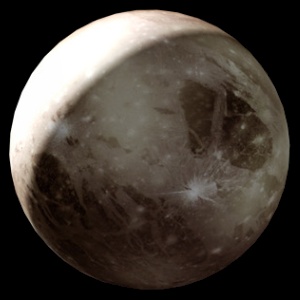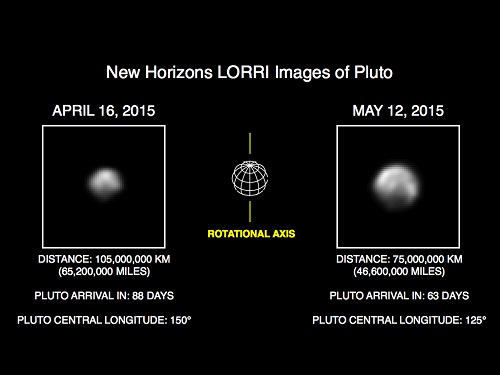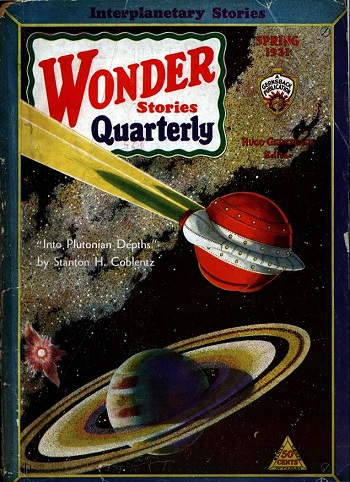
The image of Pluto on the right — an artist’s impression, to be sure (credit: NASA, ESA and G. Bacon, STScI) — suggests Ganymede to me more than Pluto, but we’ll have to wait and see what New Horizons turns up as it continues to close on its target. It’s worth thinking about how our views of this place have changed over time. The world found by Clyde Tombaugh seemed small enough when he found it, but a fraction of its light was actually coming from its yet smaller moon, which wouldn’t be discovered until USNO astronomer James Christy nailed it in 1978.
Gregory Benford depicted Pluto with a nitrogen sea in a 2006 novel called The Sunborn, one in which he explored the possibility of life at -185 degrees Celsius, the lifeforms themselves the result of an experiment by heliopause beings who drew energy from magnetic interactions far from the Sun. Even more speculative is Stephen Baxter’s story “Goose Summer” (from the Vacuum Diagrams collection of 2001), in which Plutonian life physically interacts with Charon, the latter ‘seeding’ the Plutonian surface.
But the real thing beckons. We now have images taken between May 8 and 12, downlinked last week. Here we’re looking at Pluto from a distance of 77 million kilometers using the now familiar Long-Range Reconnaissance Imager (LORRI) aboard New Horizons. The differences between this view and what we saw in April are striking. We’re now 35 million kilometers closer and have twice the pixels to work with, aided by image deconvolution techniques to tease out detail.
Here’s the May 12 imagery as contrasted with April 16 — a click on the New Horizons link will show you two other photo sets contrasting the earlier and later views.

Image: These images show Pluto in the latest series of New Horizons Long Range Reconnaissance Imager (LORRI) photos, taken May 8-12, 2015, compared to LORRI images taken one month earlier. All images have been rotated to align Pluto’s rotational axis with the vertical direction (up-down), as depicted schematically in the center panel. Between April and May, Pluto appears to get larger as the spacecraft gets closer, with Pluto’s apparent size increasing by approximately 50 percent. Pluto rotates around its axis every 6.4 Earth days, and these images show the variations in Pluto’s surface features during its rotation. All of the images are displayed using the same linear brightness scale.
The deconvolution method used to sharpen the images can, the New Horizons team reminds us, sometimes create artifacts, meaning that we’ll need to have the smaller details of these images confirmed as New Horizons gets closer. According to mission project scientist Hal Weaver (JHU/APL), as quoted in the New Horizons update linked to above, we’ll be seeing images with 5000 times better resolution when we reach closest approach during the July 14 flyby.
Are we looking at a polar cap in this imagery? Mission principal investigator Alan Stern comments:
“These new images show us that Pluto’s differing faces are each distinct; likely hinting at what may be very complex surface geology or variations in surface composition from place to place. These images also continue to support the hypothesis that Pluto has a polar cap whose extent varies with longitude; we’ll be able to make a definitive determination of the polar bright region’s iciness when we get compositional spectroscopy of that region in July.”
We’re just seven weeks away from the flyby, with Stern now moving to the east coast for the encounter operations through late July. As excitement builds, a Pluto Safari smartphone app has appeared, available for iOS as well as Android. Produced by Simulation Curriculum Corp., the free app offers interactive views of the locations of Pluto and New Horizons, along with a timeline of New Horizons mission milestones and the latest news about the spacecraft. Pluto Safari is available here in its iOS version and here for the Android iteration.

Meanwhile, looking over my collection of old science fiction magazines, I enjoyed tracking down Stanton A. Coblentz’ story “Into Plutonian Depths,” which ran in Wonder Stories Quarterly in the Spring 1931 issue. To my knowledge, this was the first story written with knowledge of Clyde Tombaugh’s discovery. Using a ‘gravity insulator,’ our protagonist and Stark, his science mentor, set out for the most distant planet known. Coblentz refers to ‘the trans-Neptunian planet’ found by Tombaugh and conjures up mystery in the name Pluto. As Stark exclaims:
“Think of it a billion miles or so beyond Neptune, a globe perhaps no larger than the earth, lost in the blackness of the outer void, its years longer than our centuries, its seasons longer than our lives! What stories it would be able to tell! Are there any living creatures there? Were any living beings ever able to endure the terror of its sunless, frozen plains? Would we find the imprint of lost races upon its shores? — races that flourished while the planet was heated from within, but that have long ago fallen in the struggle with the cold?”
And so on. It’s a lively tale, a bit mesmerizing in its day (though it goes on far too long), and it mimics the approach of New Horizons as it describes the travelers’ view of “silvery white plains and its broken and enormous mountain ranges, whose snowy summits were offset by sheer black escarpments and ravines as hideous to contemplate as the craters of the moon…” The inhabitants of the ninth planet turn out to be nothing like Benford or Baxter’s creations, and the tale turns into something closer to Rider Haggard than modern SF as it winds its way to a conclusion.
But still, what fun to think about Pluto as it was first envisioned in fiction while we have a spacecraft moving in on the Pluto/Charon system at 1.2 million kilometers per day. Each new set of New Horizons images is going to sharpen our view of a world. If only Stanton Coblentz, and for that matter Clyde Tombaugh himself, were able to watch this encounter unfold.



In 1966, Larry Niven depicted an astronaut landing on that atmosphere, its hot exhaust releasing the frozen methane and oxygen, so the entire planet bursts into flames. Niven later imagined an even odder fate. A stranded astronaut freezes, only to find that his nervous system has become superconducting, so he can still think, frozen solid. He watches the stars but sunrise heats him and shuts down his mind, only to awake again at night. Only on Pluto could this happen. Another expedition will come. What can he do? The story’s title answers that: “Wait it Out.”
For more on “Wait It Out,” a personal favorite, see this Centauri Dreams post:
https://centauri-dreams.org/?p=28346
I read Heinlein’s “Have spacesuit, will travel” in junior high back in the early 60’s. Lots of hard science for a “juvenile” book. The bad guy’s base was on Pluto. I was a space travel fan forever after reading that story.
I’m hooked…
“Wait It Out” was a favourite of mine – I think I first read it in Asimov’s anthology “The Science Fiction Solar System” just a few years before its setting in 1989. The unfortunate cryonaut/astronaut encountered Plutonians, who were living blobs of helium super-fluid. However Pluto never gets cold enough for helium to liquefy as depicted. Nor does the “Dark Side” of Mercury, as in another Niven story, “The Coldest Place.” But then several Niven settings haven’t survived the revelations of 1960s space-probes – his acidic NOx Mars was disconfirmed by c.1964, while the Stygian “searing black calm” at the bottom of Venus’s atmosphere lasted until c.1975. Mercury’s rotation was confirmed by c.1965, but the high density Pluto was a maybe up until 1978.
Clyde Tombaugh searched extensively for worlds beyond Pluto once he had made his famous discovery in 1930. He said he found nothing else out that way. However, did anyone check his plates later on? Did he come across some other Kuiper type bodies and miss them? I am amazed it took until 1992 to find another friend for Pluto.
If nothing else, searching the archives could give us new discoveries of KBOs and refine orbits for existing worlds we know of.
Every time a new KBO is discovered, people go back through archives of older observations and see if the object is present on them, in order to determine its orbit.
Correct me if I’m wrong on this, but I don’t think there’s anything remotely the same size in Pluto’s neighborhood. Nearly all of the other “plutinos” (objects in a 3:2 resonance with Pluto) are tiny, and Tombaugh would have been unlikely to find them. The second-largest plutino, by far, is Charon, and he didn’t have remotely the technology at his disposal to ever resolve it so close to Pluto. The third-largest, Orcus, is about one-third the size of Pluto, and three full magnitudes dimmer. The only TNO’s we’ve found anywhere, other than Eris, are only about 60 percent of Pluto’s size and almost always much lower albedo. Hence, much harder to spot even if someone were looking for them, which few people were.
Given those circumstances, it’s not that strange that no one found any KBO but Pluto and Charon (a “double dwarf planet,” IMO) prior to 1992.
I meant 3:2 resonance with Neptune, obviously…
A (very) few more details on Pluto
Posted by Emily Lakdawalla
2015/06/01 21:09 UTC
Last week the New Horizons mission released a few new processed versions of their latest and greatest images of Pluto. They’re the best images of Pluto that Earth has ever seen, but they’re still a long way from what New Horizons will be able to show us, six weeks from now.
A lot of people are commenting that Pluto does not look round in these photos. You’re right, it doesn’t look round, but that’s just an artifact of the way the camera works and the way the images have been enlarged and processed. The processing tends to turn anything that is especially bright into something that looks like a mountain, and anything that is especially dark into something that looks like a hole. In fact, since Pluto is quite large enough for the force of its self-gravity to overcome the strength of its icy material, there is no question that it will be very much round, more round than Ceres. (Pluto has the same density as Ceres, so has similar ice/rock composition, but Pluto has more than 14 times Ceres’ mass, so its gravity is significantly stronger.) Roundness is one of the very few things that we can confidently predict about Pluto before New Horizons’ flyby, because basic physics does a remarkably good job of predicting bulk physical properties of space objects. To give you a sense of what the photos looked like before manipulation, here’s a raw image taken from the New Horizons website.
Full article here:
http://www.planetary.org/blogs/emily-lakdawalla/2015/0601-a-very-few-more-details-on-pluto.html
Five Weeks to Pluto: The Strange Discovery of Planet X and a World Like No Other (Part 1) – By Ben Evans:
http://www.americaspace.com/?p=82806
Part 2 here:
http://www.americaspace.com/?p=82812
To quote (from Part 2):
In the years after Charon’s discovery, estimates were made by Robert Harrington of its orbit and the mass of Pluto itself; in effect, the moon had provided a significant breakthrough in our understanding of the ninth planet. The result confirmed that Pluto is about a fifth as massive as our Moon, thus nowhere near sufficient to have perturbed Uranus’ or Neptune’s orbits. Moreover, its relationship with Charon was less of a host-satellite one, and more of a “binary-planet.” Charon orbits about 11,700 miles (18,800 km) from Pluto’s surface, circling every 6.4 Earth-days, exactly matching the rotation rate of its larger partner. In the same manner as our Moon, Charon keeps the same face directed toward Pluto in perpetuity. However, unlike our planet, which spins 29.5 times for each lunar cycle, one side of Pluto always faces Charon and vice versa. An observer on Pluto’s Charon-facing side would see the moon hanging in the sky, unchanging its position over the years, whilst an observer on the planet’s space-facing side would not even know that his world possessed a moon.
Surprisingly, Charon’s north-south motion—indicative of the fact that the pole of its orbit resides within the plane of the ecliptic—provided clear evidence that Pluto’s own rotational axis was tipped very closely to the ecliptic, in a similar fashion to Uranus. It soon became apparent that Charon’s orbital plane would be seen edge-on from Earth in the mid-1980s and proved extremely fortunate in terms of timing, for these mutual eclipses occur only twice in Pluto’s 248-Earth-year orbit of the Sun. “We immediately appreciated our good fortune,” explained Cruikshank in a chapter on Pluto, Triton and Charon for the fourth edition of The New Solar System. “Had Charon been discovered in, say, 1993, we would had to wait until the 22nd century to witness the next series of overlappings.” The alignments enabled astronomers to spectroscopically monitor the faint emissions from the system, revealing an approximate diameter for Pluto about two-thirds the size of our Moon.
The combined density of the two worlds suggested a composition of 60-70 percent rocky materials, with 30-40 percent ices. Moreover, the rotational locking of the two worlds was suggestive of Charon being a large body, relative to its host, and celestial dynamicists have suggested that the size ratio between the two is closer than any other host-satellite pairing in the Solar System. Present estimates show Charon to be a little more than half the size of its host, with an equatorial diameter of about 750 miles (1,200 km), compared to Pluto’s 1,470 miles (2,370 km). Spectroscopy has also revealed Pluto to be predominantly coated with ices of nitrogen and methane. This can be compared to less volatile water ices in the case of Charon, with patches of ammonia hydrates and water crystals detected in 2007, suggesting the possible presence of active cryovolcanism or cryogeysers, perhaps not dissimilar to those observed on Neptune’s moon, Triton. Current thinking suggests that Charon’s overwhelmingly icy composition may indicate that it was formed as a consequence of a giant impact into Pluto’s icy mantle.
An interview with Jim Christy: How “defective” images revealed Pluto as a double planet
Charon’s discoverer says when he first spotted a blob on Pluto’s side in 1978, he thought there’d been an explosion on the planet.
By Eric Betz | Published: Tuesday, June 9, 2015
On June 22, 1978, US Naval Observatory (USNO) astronomer James Christy was getting ready to take some well-deserved time off. He and his wife, Charlene, were moving from an apartment to their newly purchased home in the Maryland suburbs outside Washington, D.C. So Christy caught up on all the tasks he could find around the office and checked in with his supervisor, Robert Harrington, to see if there was anything else before he left for the week.
The supervisor reached into his desk and pulled out a set of Pluto images that Christy had requested and waited so long to get he’d forgotten he was expecting them.
Christy’s job at USNO was to measure the moons of Uranus and Neptune using images collected by the observatory’s 61-inch Strand Telescope in Flagstaff, Arizona. Those measurements were forwarded on to NASA’s Voyager program so that Jet Propulsion Laboratory engineers could plot them. But Christy realized that he could easily extend his efforts to Pluto, which USNO hadn’t emphasized much in several years. For some reason, even though his proposed observations were approved, the folks in Flagstaff hadn’t gotten around to taking them.
Harrington handed over six photographic plates that were taken in April and May of that year.
“The plates had been marked by whoever looked at it in Flagstaff as ‘image defective,’ which is probably why Bob didn’t measure them himself or didn’t look at them,” says Christy. “I started to measure the plates. The way the images looked, you wouldn’t expect to get a decent measurement of Pluto.”
It was obvious the planet was blurry. It was elongated.
Full article here:
http://www.astronomy.com/year-of-pluto/2015/06/an-interview-with-jim-christy-how-defective-images-revealed-the-first-double-planet
To quote:
Part of the reason why Christy and other astronomers hadn’t looked for satellites of Pluto earlier is that one of the pillars of planetary science, Gerard Kuiper, who discovered Uranus’ moon Miranda and Neptune’s moon Nereid, said he’d already looked. Kuiper was also one of Christy’s professors at the University of Arizona, and he spent two nights on the 200-inch Hale Telescope on Mount Palomar in the 1950s observing Pluto.
“It’s strange,” Christy says. “You accept it. This is your hero, and he says it’s not there. So I had never looked. Nobody ever did.”